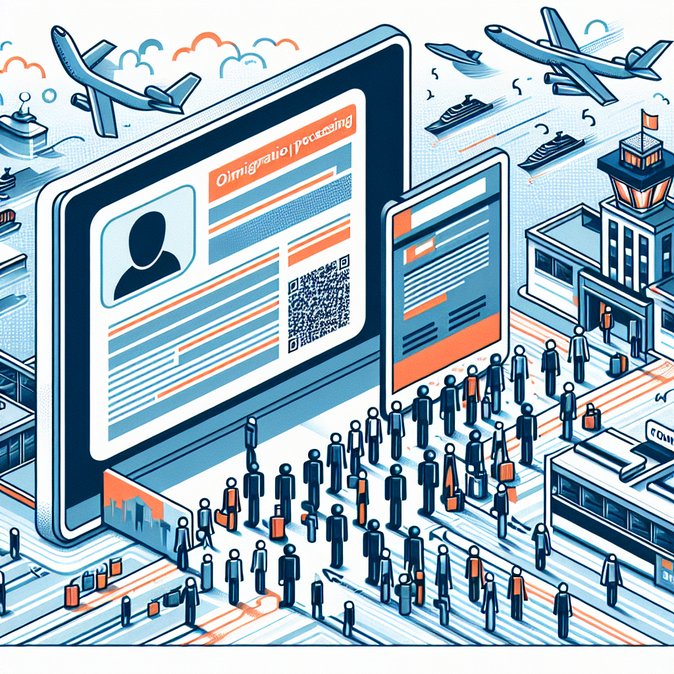
On 8 November 2025 China’s National Immigration Administration (NIA) quietly published implementation details for the most far-reaching border-modernisation package since the country reopened after the pandemic.
The centre-piece is a fully digital “Foreigners Arrival Card.” From 20 November, most travellers will be able – and in practice are expected – to complete the health/arrival declaration on-line before boarding a flight to China. Submission can be made through the NIA website, China’s unified Government Service Platform, the “NIA 12367” mobile app, or brand-new WeChat and Alipay mini-programs. A dynamic QR code on the paper form shown at airline check-in links directly to the mobile version. Paper cards and tablet kiosks will remain as fall-backs for passengers without smartphones or during system outages, but airlines have been instructed to channel passengers towards the QR code to reduce on-arrival processing times.
Border officials told state media that pre-clearance of data will shave “30-45 seconds per passenger” off inspection times – an improvement that matters when daily inbound volumes are again topping 200 000. Seven categories of travellers – including Chinese permanent-resident card holders, cruise passengers and 24-hour air-side transit passengers – are exempted from filing the form.
![China introduces digital arrival card and widens visa-free transit at 20 additional ports]()
The same notice confirms that China’s 24-hour air-side visa-free transit scheme has been copied to ten additional international airports (Tianjin, Dalian, Nanjing, Fuzhou, Qingdao, Wuhan, Nanning, Haikou, Chongqing and Kunming). These locations join the eight existing hubs, allowing through-ticketed passengers to stay inside the sterile zone and bypass immigration entirely.
For travellers who do wish to enter the country, the popular 240-hour (10-day) visa-free transit programme has been expanded once again. Five Guangdong entry points have been added – Pazhou Ferry Terminal, Hengqin Port, the Hong Kong-Zhuhai-Macao Bridge Port, Zhongshan Port and the West Kowloon high-speed-rail terminus – raising the nationwide network to 65 ports in 24 provinces. Citizens of the 55 eligible countries can now combine the fast-growing Greater Bay Area with side-trips to the Yangtze River Delta, Beijing and other permitted regions on a single 10-day stay.
Practical implications for corporate mobility teams are substantial:
• Digital pre-clearance means assignees and business travellers must be briefed to complete the form before departure and to take screenshots of the final confirmation page as evidence for airlines.
• Carriers and travel managers should update check-in SOPs; failure to ensure the form is submitted may lead to denied boarding or delays on arrival.
• Companies routing personnel through secondary hubs such as Wuhan or Qingdao can now use those airports for true same-calendar-day connections without immigration control, cutting risk and dwell time.
• Project teams operating in the Greater Bay Area gain five new ports for 10-day visa-free stays, making Guangzhou trade fairs and Hengqin R&D sites easier to access.
In combination with China’s fast-expanding unilateral visa-waiver list, the digital arrival card is another signal that Beijing is betting on frictionless entry to revive inbound tourism, MICE business and foreign investment after three turbulent years.
The centre-piece is a fully digital “Foreigners Arrival Card.” From 20 November, most travellers will be able – and in practice are expected – to complete the health/arrival declaration on-line before boarding a flight to China. Submission can be made through the NIA website, China’s unified Government Service Platform, the “NIA 12367” mobile app, or brand-new WeChat and Alipay mini-programs. A dynamic QR code on the paper form shown at airline check-in links directly to the mobile version. Paper cards and tablet kiosks will remain as fall-backs for passengers without smartphones or during system outages, but airlines have been instructed to channel passengers towards the QR code to reduce on-arrival processing times.
Border officials told state media that pre-clearance of data will shave “30-45 seconds per passenger” off inspection times – an improvement that matters when daily inbound volumes are again topping 200 000. Seven categories of travellers – including Chinese permanent-resident card holders, cruise passengers and 24-hour air-side transit passengers – are exempted from filing the form.

The same notice confirms that China’s 24-hour air-side visa-free transit scheme has been copied to ten additional international airports (Tianjin, Dalian, Nanjing, Fuzhou, Qingdao, Wuhan, Nanning, Haikou, Chongqing and Kunming). These locations join the eight existing hubs, allowing through-ticketed passengers to stay inside the sterile zone and bypass immigration entirely.
For travellers who do wish to enter the country, the popular 240-hour (10-day) visa-free transit programme has been expanded once again. Five Guangdong entry points have been added – Pazhou Ferry Terminal, Hengqin Port, the Hong Kong-Zhuhai-Macao Bridge Port, Zhongshan Port and the West Kowloon high-speed-rail terminus – raising the nationwide network to 65 ports in 24 provinces. Citizens of the 55 eligible countries can now combine the fast-growing Greater Bay Area with side-trips to the Yangtze River Delta, Beijing and other permitted regions on a single 10-day stay.
Practical implications for corporate mobility teams are substantial:
• Digital pre-clearance means assignees and business travellers must be briefed to complete the form before departure and to take screenshots of the final confirmation page as evidence for airlines.
• Carriers and travel managers should update check-in SOPs; failure to ensure the form is submitted may lead to denied boarding or delays on arrival.
• Companies routing personnel through secondary hubs such as Wuhan or Qingdao can now use those airports for true same-calendar-day connections without immigration control, cutting risk and dwell time.
• Project teams operating in the Greater Bay Area gain five new ports for 10-day visa-free stays, making Guangzhou trade fairs and Hengqin R&D sites easier to access.
In combination with China’s fast-expanding unilateral visa-waiver list, the digital arrival card is another signal that Beijing is betting on frictionless entry to revive inbound tourism, MICE business and foreign investment after three turbulent years.









